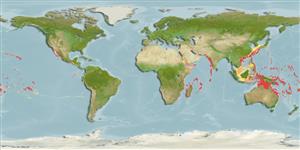Common names from other countries
>
Ophidiiformes (Cusk eels) >
Carapidae (Pearlfishes) > Carapinae
Etymology: Encheliophis: Greek, enchelys, = eel + Greek, ophis = serpent (Ref. 45335).
More on author: Kaup.
Environment: milieu / climate zone / depth range / distribution range
पारिस्थितिकी
समुद्री ड़िमरसल; गहराई सीमा 1 - 150 m (Ref. 34024). Tropical
Indo-Pacific: Mauritius to the Society Islands, north to Taiwan and the Yaeyama Islands; including Mariana and Caroline islands.
आकार / वज़न / Age
Maturity: Lm ? range ? - ? cm
Max length : 30.0 cm TL पुल्लिंग / अलिंग; (Ref. 4104)
पृष्ठीय सौफट रेज़ (सम्पूर्ण) : 31 - 42; ऐनल सौफट रेज़: 45 - 57; जानवरों की रीड़ का जोड़: 119 - 126. Eel-like, moderate to shallow body depth; maxilla free and movable; cardiform teeth present; branchiostegal membranes partly or completely united; swim bladder with thin terminal membrane or bulb; lacking enlarged dentary or premaxillary fangs, dentary diastema, pelvic fins, and swim bladder rocker bone (Ref. 34024). Pectoral fins small, less than 29% head length; body thick, robust and highly pigmented (Ref. 34024).
Uncommon species (Ref. 34024). Lives within holothurians (e.g. Thelenota ananas and Bohadschia argus) (Ref. 1602).
Life cycle and mating behavior
Maturities | पुनरुत्पत्ति | Spawnings | Egg(s) | Fecundities | लार्वा
Nielsen, J.G., D.M. Cohen, D.F. Markle and C.R. Robins, 1999. Ophidiiform fishes of the world (Order Ophidiiformes). An annotated and illustrated catalogue of pearlfishes, cusk-eels, brotulas and other ophidiiform fishes known to date. FAO Fish. Synop. 125(18):178p. Rome: FAO. (Ref. 34024)
IUCN Red List Status (Ref. 130435)
CITES (Ref. 128078)
Not Evaluated
Threat to humans
Harmless
Human uses
मात्स्यिकी: कोई रुचि बग़ैर
साधन
Special reports
Download XML
इंटरनेट स्रोत
Estimates based on models
Preferred temperature (Ref.
115969): 23.6 - 28.9, mean 27.5 (based on 920 cells).
Phylogenetic diversity index (Ref.
82804): PD
50 = 0.5078 [Uniqueness, from 0.5 = low to 2.0 = high].
Bayesian length-weight: a=0.00102 (0.00046 - 0.00225), b=3.06 (2.88 - 3.24), in cm Total Length, based on all LWR estimates for this body shape (Ref.
93245).
Trophic level (Ref.
69278): 3.4 ±0.3 se; based on size and trophs of closest relatives
Fishing Vulnerability (Ref.
59153): Low vulnerability (20 of 100).
